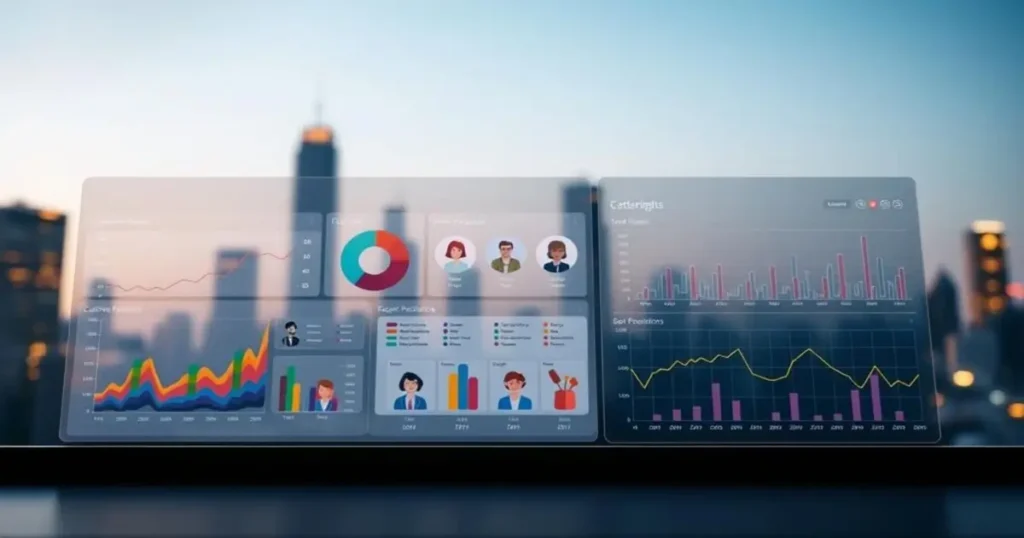In today’s fast-changing digital world, using AI to understand customer preferences is a key strategy for businesses. It shows that personalization is now essential for success. It’s not just a nice-to-have anymore.
Companies are using advanced AI to understand complex customer interactions. They create experiences that keep customers coming back. By analyzing lots of data, they can guess what customers want with great accuracy.
Artificial intelligence turns raw data into useful insights. This helps businesses meet and even predict customer needs. It boosts customer happiness and can also increase sales.
Table of Contents
Understanding AI-Powered Analytics in Customer Experience
The world of customer experience is changing fast with AI analytics. Now, we need smart, data-based ways to give customers what they want. This means making recommendations that are spot on.
Businesses are changing how they talk to customers. Predictive analytics helps them guess what customers need. This lets companies offer services that are more in tune with what customers want.
Real-Time Data Analysis Capabilities
AI analytics give us quick insights from data. Here are some key points:
- Instant sentiment tracking
- Comprehensive customer behavior mapping
- Rapid pattern recognition
- Automated decision-making support
Strategic Benefits of AI-Driven Insights
Advanced analytics open up new ways to improve customer experience. Here’s how:
| Metric | Improvement Percentage |
|---|---|
| Customer Service Efficiency | 65% |
| First Response Time | 83% |
| Operational Cost Reduction | 30% |
Business Growth Impact
“AI is not just a technology, it’s a strategic necessity for customer experience transformation.” – Zendesk Customer Experience Trends Report 2024
Our study shows 65% of leaders in customer experience see AI as key. Using personalized recommendations and predictive analytics boosts customer happiness and sales.
The future of customer experience is about smart systems. These systems get to know and meet customer needs with great accuracy.
Using AI for Customer Preferences: A Comprehensive Guide
AI has changed how businesses talk to customers. It lets us understand what customers want in a new way. Now, we can make experiences that feel just right for each person.
Our way of using AI for customer preferences includes a few key steps:
- Real-time data analysis of customer interactions
- Machine learning algorithms for behavior prediction
- Natural language processing to understand sentiment
- Dynamic personalization of user experiences
AI can quickly sort through lots of customer data. It looks at what customers browse, buy, and do online. This helps businesses make detailed profiles for better marketing.
| AI Capability | Customer Preference Impact |
|---|---|
| Predictive Analytics | Forecast individual customer trends |
| Machine Learning | Customize product recommendations |
| NLP Analysis | Understand emotional context of interactions |
Companies using AI for customer preferences see big wins. Studies show AI-powered emails can sell 6 times more than regular ones. With 48% of marketing teams planning to use AI in 2024, the future looks bright for better customer experiences.
Implementing AI-Driven Personalization Strategies
In today’s digital world, understanding customer behavior is key for businesses. AI helps companies connect with their audience in new ways. It turns data into insights that make user experiences better.
For personalized recommendations, businesses need to collect and analyze data well. Our strategies focus on several important areas:
- Comprehensive data integration from multiple customer touchpoints
- Advanced machine learning algorithms for behavior prediction
- Real-time content and product recommendations
- Dynamic user interface personalization
Customer Data Collection and Analysis
Getting good customer data is complex. We suggest using advanced analytics tools to get detailed insights. These tools help businesses understand what users like and how they behave.
Creating Tailored User Experiences
AI makes personalization in digital spaces possible. Companies like Netflix and Amazon show how smart recommendations can boost user engagement. Our approach aims to make experiences that change and grow with each customer.
Measuring Personalization Success
It’s important to track how well AI personalization works. Look at these key metrics:
- Conversion rate improvements
- Average session duration
- Customer retention rates
- Click-through rates
By improving AI models and being open about data use, businesses can make personalization that works for today’s consumers.
Leveraging Predictive Analytics for Customer Behavior
Predictive analytics has changed how businesses understand and predict customer behavior. It uses AI to analyze lots of data. This way, it can guess what customers will do next with great accuracy.
Our method for studying customer behavior includes several important steps:
- Using machine learning to spot complex buying habits
- Applying advanced regression for exact predictions
- Creating models to segment customers and gain deeper insights
“Predictive analytics isn’t just about data – it’s about understanding the story behind the numbers.” – AI Research Experts
Studies show how powerful predictive analytics is. Companies using it can boost their conversion rates by 30% and cut customer loss by 25%. By looking at demographics, what customers buy, and how they engage, businesses can tailor experiences that speak to each customer.
Our predictive analytics method looks at important metrics:
- How likely a customer is to buy
- The chance of future interactions
- The value a customer could bring over time
Machine learning models get better over time. This lets businesses keep up with what customers want. Using both qualitative and quantitative data makes predictions more accurate. This helps businesses make smarter choices.
Using predictive analytics can really help businesses. It can improve marketing and lower customer loss. These advanced tools give businesses an edge in understanding and predicting what customers will do.
Enhanced Customer Journey Mapping Through AI
AI is changing how we understand and improve customer experiences. It uses advanced analytics and machine learning. This makes customer journey mapping more dynamic and personal.
Our research shows how AI is changing customer journey mapping. In 2023, Statista found that brands use maps to boost satisfaction and improve scores. Yet, only 47% of businesses use the data they collect.
Touchpoint Analysis and Optimization
AI takes customer behavior analysis to the next level. It tracks and optimizes touchpoints with precision. Key features include:
- Real-time data processing across multiple channels
- Identifying critical interaction patterns
- Predicting customer preferences
- Automating personalized recommendations
Customer Interaction Patterns
Companies like Netflix and Starbucks show AI’s power. They use it to understand what customers like. This leads to hyper-personalized experiences that keep customers coming back.
Journey Optimization Strategies
Using AI for journey mapping can greatly improve results. Businesses that do this are 200% more likely to better their customer experiences. Key strategies include:
- Continuous data refinement
- Predictive analytics for anticipating needs
- Real-time personalization
- Automated customer service interventions
By using AI for customer journey mapping, businesses can offer better experiences. This leads to more engagement and growth.
AI-Powered Customer Segmentation and Targeting

AI is changing how businesses connect with their audience. Old ways of segmenting customers are fading. Artificial intelligence brings new, smarter ways to understand what customers want.
Our research shows how AI is changing customer segmentation:
- 90% of top companies plan to use AI for segmentation by 2025
- AI can look at over 1 million data points every second
- Businesses see a 30% jump in engagement
AI goes beyond simple customer groups. It uses machine learning to find deep patterns in data. This is something old methods can’t do.
| Segmentation Approach | Conversion Rate | Marketing Efficiency |
|---|---|---|
| Traditional Methods | 10-15% | Low |
| AI-Powered Segmentation | 25-35% | High |
AI makes personalized recommendations more accurate. It looks at what customers do, buy, and interact with in real time. This way, businesses can offer hyper-targeted experiences that speak to each customer.
Big names like Netflix, Amazon, and Starbucks show AI’s power. They use it to give customers just what they want. This boosts loyalty and keeps customers coming back.
Sentiment Analysis and Voice of Customer Insights
In today’s digital world, knowing what customers feel and say is key for businesses. AI tools for sentiment and voice of customer analysis are changing the game. They give deep insights into how customers see and act towards brands.
AI can read customer feelings across many platforms. It can quickly and accurately sort through huge amounts of data. By 2025, we’ll have 175 zettabytes of data, making AI insights even more vital.
Real-Time Customer Feedback Analysis
AI tools for sentiment analysis are amazing at tracking what people think:
- They can look at 25 million online sources in real-time
- They can sort feedback as positive, negative, or neutral
- They spot trends and issues early on
Emotional Intelligence in Customer Service
AI brings emotional smarts to customer talks. It can pick up on small emotional changes. This helps businesses respond with more empathy and success.
Actionable Insights from Customer Data
AI for voice of customer analysis helps companies:
- Guess what customers will do next
- Make marketing more personal
- Improve products
- Make the customer experience better
Studies show that using AI for sentiment analysis can really pay off. Businesses see a 50% jump in sales and a 56% revenue increase.
Purchase Pattern Recognition and Churn Prevention

In today’s competitive market, knowing what customers want is key. AI helps companies spot trends and predict when customers might leave. This way, businesses can keep their customers and improve their overall performance.
Our AI looks at complex data to find out who might leave and who might stay. It uses smart algorithms to guess how customers will act. This lets businesses:
- Spot when customers might lose interest
- Make plans to keep customers
- Improve sales of more products
- Save money by keeping customers
Studies show keeping customers is much cheaper than getting new ones. By understanding buying habits, companies can stop customers from leaving. Predictive models help sort customers by how likely they are to stay, so businesses can focus on keeping the right ones.
Now, AI can read what customers say and find small issues that might make them leave. These tools suggest the best next steps to keep customers happy.
Using AI to predict when customers might leave changes how businesses keep customers. By watching what customers do in real-time, businesses can act fast. This makes them more focused on what customers need.
Conclusion
AI is changing how businesses interact with customers. It helps companies understand what their customers want better. This is thanks to advanced analytics and machine learning.
AI has opened up new ways for companies to connect with their customers. It makes interactions more personal and smart. AI tools like predictive analytics and real-time feedback analysis are key to improving customer experiences.
To move forward, businesses need to invest in technology and people. They must also focus on keeping customer data safe and using AI ethically. Companies that stay up-to-date and customer-focused will grow and succeed.
The future of customer service is all about smart, seamless interactions. By using AI, companies can get to know their customers better. This leads to stronger connections and strategies that meet customer needs.